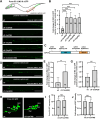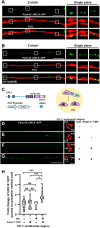CFI-1 functions unilaterally to restrict gap junction formation in C. elegans
- PMID: 39679967
- PMCID: PMC11829774
- DOI: 10.1242/dev.202955
CFI-1 functions unilaterally to restrict gap junction formation in C. elegans
Abstract
Electrical coupling is vital to neural communication, facilitating synchronized activity among neurons. Despite its significance, the precise mechanisms governing the establishment of gap junction connections between specific neurons remain elusive. Here, we identified that the PVC interneuron in Caenorhabditis elegans forms gap junction connections with the PVR interneuron. The transcriptional regulator CFI-1 (ARID3) is specifically expressed in the PVC but not PVR interneuron. Reducing cfi-1 expression in the PVC interneuron leads to enhanced gap junction formation in the PVR neuron, while ectopic expression of cfi-1 in the PVR neuron restores the proper level of gap junction connections in the PVC neuron, along with the normal touch response. These findings unveil the pivotal role of CFI-1 in bidirectionally regulating the formation of gap junctions within a specific neuronal pair, shedding light on the intricate molecular mechanisms governing neuronal connectivity in vivo.
Keywords: C. elegans; CFI-1/ARID3; Gap junction; Neural circuitry; Transcription factor.
© 2025. Published by The Company of Biologists.
Conflict of interest statement
Competing interests The authors declare no competing or financial interests.
Figures





Similar articles
-
Cell context-dependent CFI-1/ARID3 functions control neuronal terminal differentiation.Cell Rep. 2023 Mar 28;42(3):112220. doi: 10.1016/j.celrep.2023.112220. Epub 2023 Mar 9. Cell Rep. 2023. PMID: 36897776 Free PMC article.
-
The Snail transcription factor CES-1 regulates glutamatergic behavior in C. elegans.PLoS One. 2021 Feb 2;16(2):e0245587. doi: 10.1371/journal.pone.0245587. eCollection 2021. PLoS One. 2021. PMID: 33529210 Free PMC article.
-
The LIM and POU homeobox genes ttx-3 and unc-86 act as terminal selectors in distinct cholinergic and serotonergic neuron types.Development. 2014 Jan;141(2):422-35. doi: 10.1242/dev.099721. Epub 2013 Dec 18. Development. 2014. PMID: 24353061 Free PMC article.
-
Gap junctions: historical discoveries and new findings in the Caenorhabditiselegans nervous system.Biol Open. 2020 Sep 3;9(8):bio053983. doi: 10.1242/bio.053983. Biol Open. 2020. PMID: 32883654 Free PMC article. Review.
-
Gap junctions in C. elegans: Their roles in behavior and development.Dev Neurobiol. 2017 May;77(5):587-596. doi: 10.1002/dneu.22408. Epub 2016 Jun 22. Dev Neurobiol. 2017. PMID: 27294317 Free PMC article. Review.
Cited by
-
Interlocked transcription factor feedback loops maintain and restore touch sensation.bioRxiv [Preprint]. 2025 May 20:2025.05.15.654349. doi: 10.1101/2025.05.15.654349. bioRxiv. 2025. PMID: 40475441 Free PMC article. Preprint.
References
MeSH terms
Substances
Grants and funding
LinkOut - more resources
Full Text Sources
Research Materials
Miscellaneous

